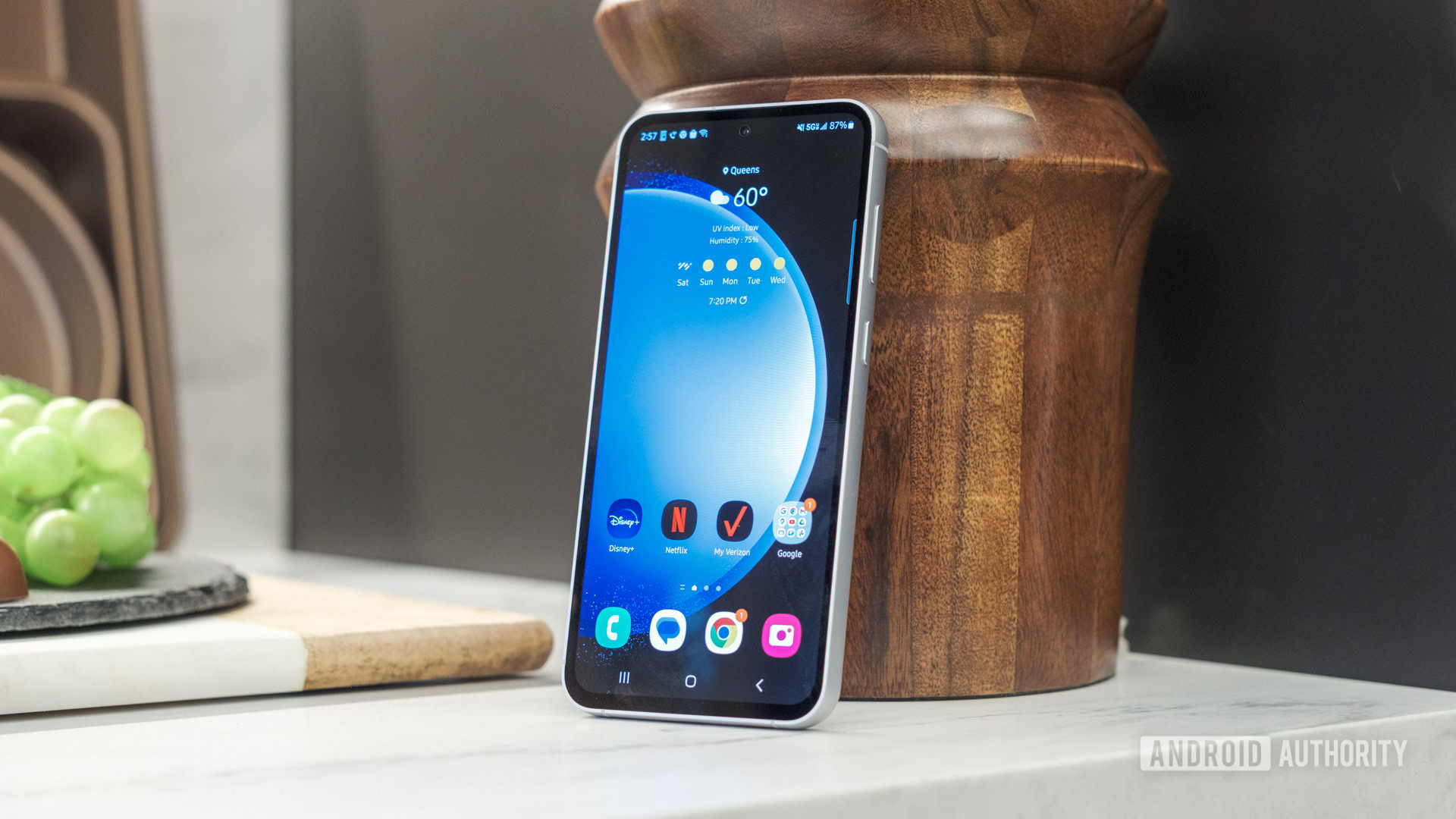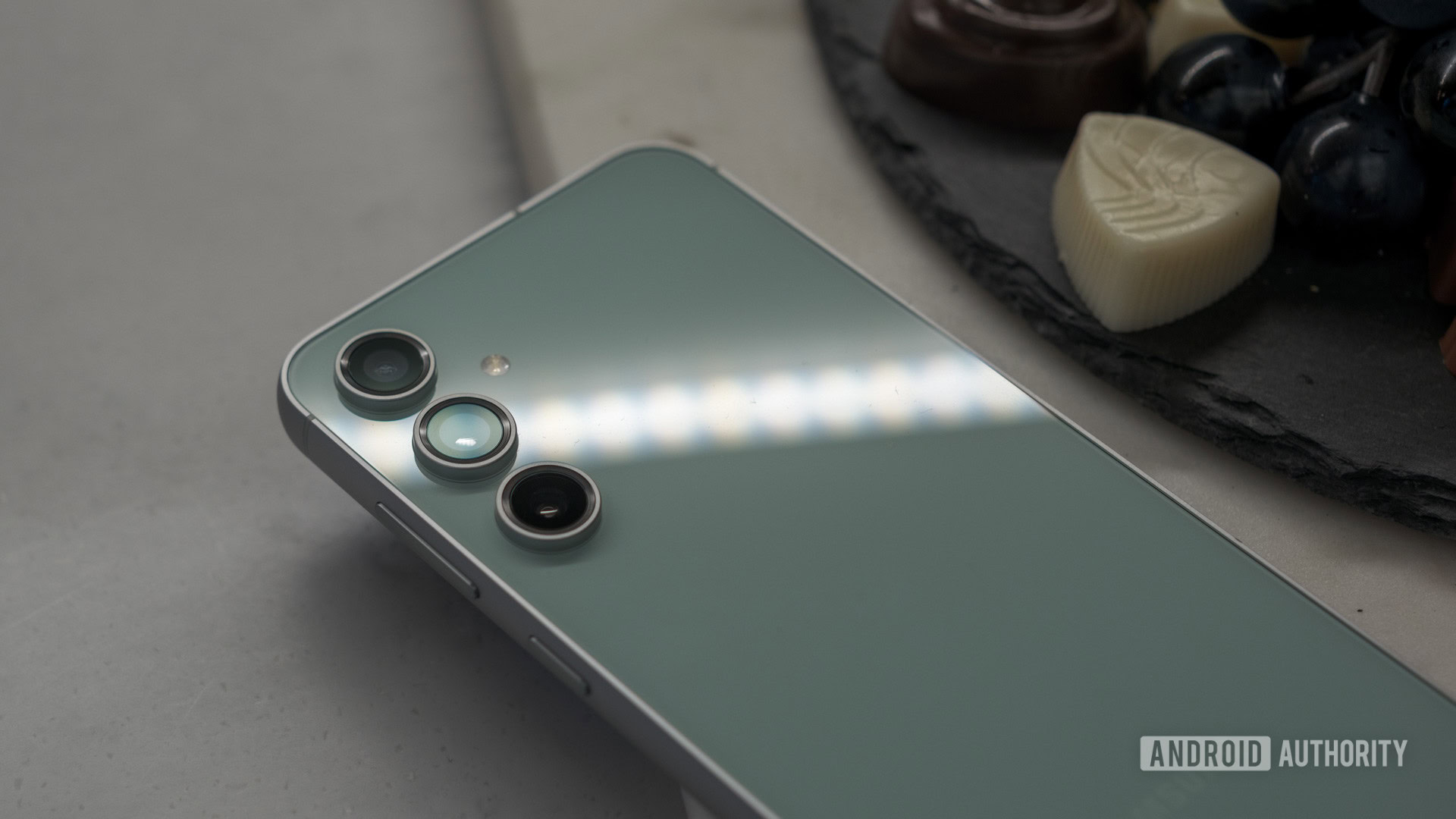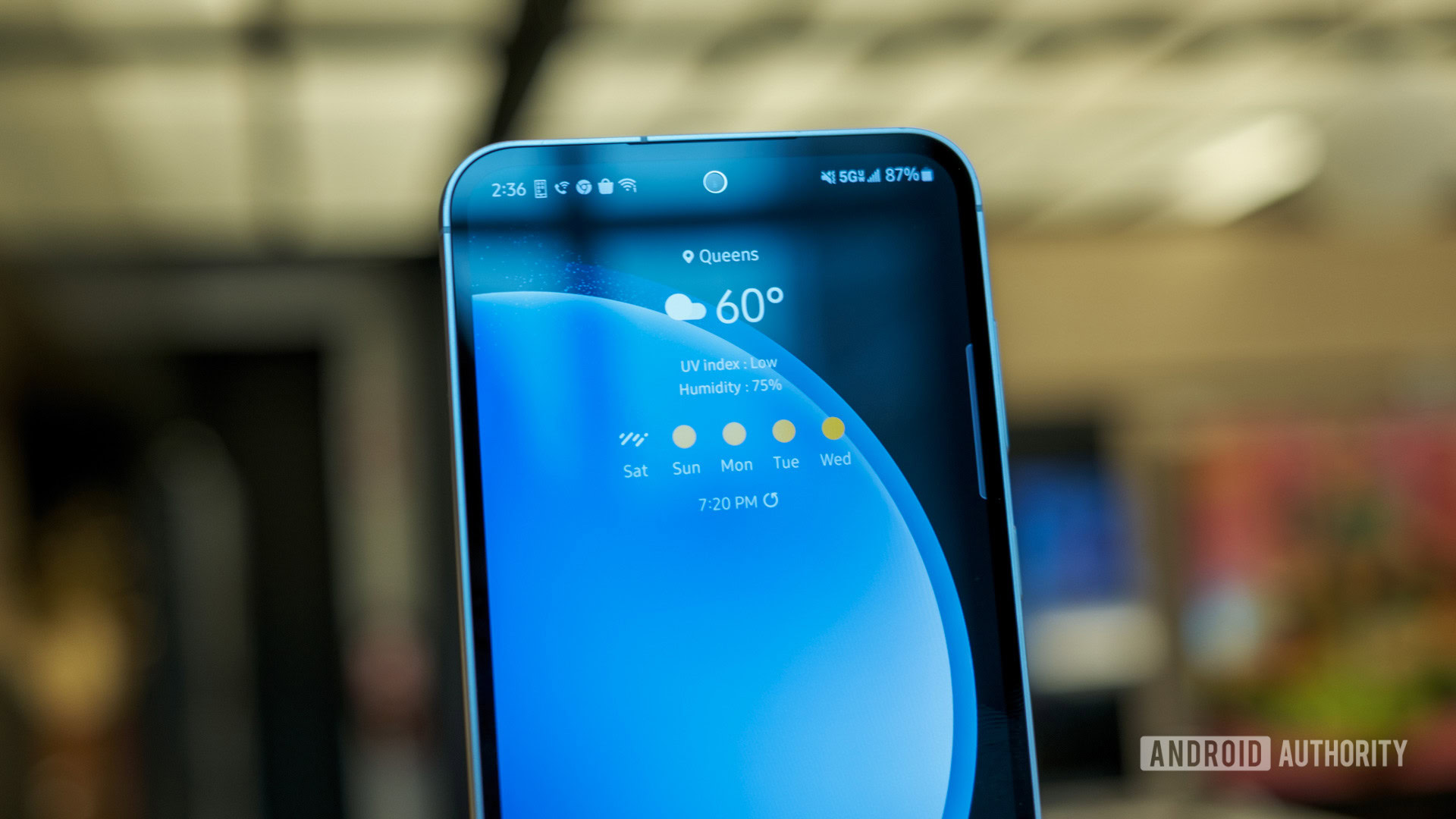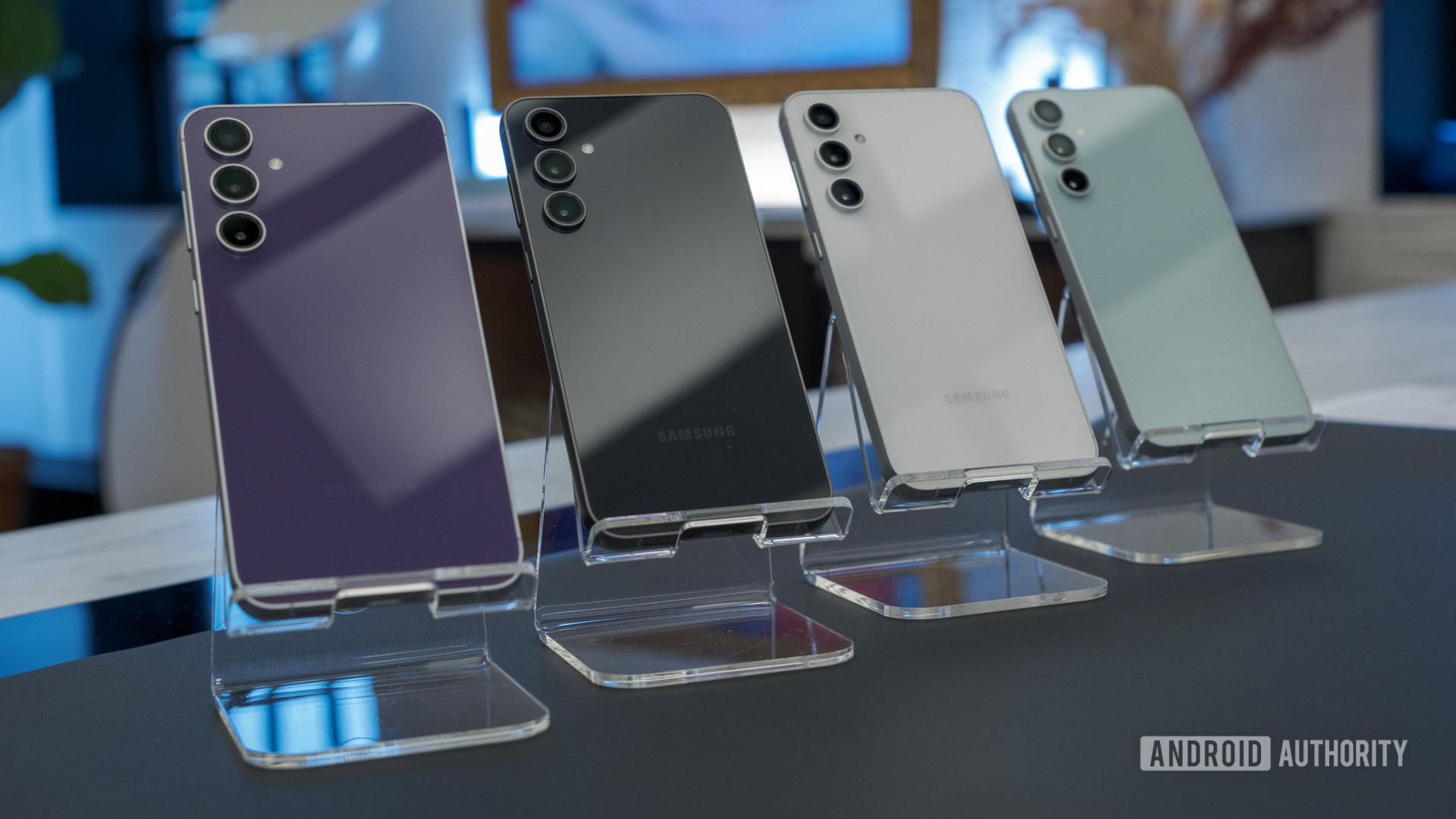Affiliate links on Android Authority may earn us a commission. Learn more.
Galaxy S23 FE hands-on: First impressions of Samsung's cheaper S23
Published onOctober 3, 2023
Samsung’s Fan Edition (or FE) series has had its highs and lows over the last few years. It earned a place in our hearts with the well-positioned Galaxy S20 FE, only to fall out of favor with the too-little, too-late Galaxy S21 FE. Then, Samsung skipped the series altogether when the Galaxy S22 family hit the market. Now, it’s back and hoping to recapture a little of its initial magic. Here’s what I thought of the Samsung Galaxy S23 FE during a short hands-on session with the device.
Another familiar face

The apple doesn’t fall from the tree, as they say. In the case of the Samsung Galaxy S23 FE, the apple doesn’t even hit any branches on the way down. It’s about as close to a clone of its flagship inspiration as can be, lifting the flat display, gently rounded edges, and minimal camera design that we generally raved about on the Galaxy S23 series. That said, the Samsung Galaxy S23 FE does make a few changes to bring the cost down and pick up a little of its own identity.
The Gorilla Glass Victus rear panel that lent its toughness to the Galaxy S23 series is gone, with a more plastic-feeling Gorilla Glass 5 panel. While it doesn’t feel bad in the hand, it has a glossy finish that picks up fingerprints from the minute you pick up the phone. On the bright side, the phone comes in a few different colorful finishes, adding Mint and Purple to Samsung’s standard Cream and Graphite (white and black).
The Galaxy S23 FE ticks all the upper mid-range boxes.
Overall, the Galaxy S23 FE feels like a premium Android phone, but there’s a further downgrade Samsung hasn’t included on early spec sheets: the display glass is now Gorilla Glass 5 too, not Victus like the S21 FE. At least there’s an aluminum frame that promises to put up with daily life.
Mentioning the 6.4-inch display, it’s otherwise excellent. The Dynamic AMOLED 2x panel pairs a crisp Full HD+ resolution with a smooth 120Hz refresh rate that offers a comfortable viewing experience, even if you’re just catching up on Android Authority‘s YouTube channel, as I did during my time with the device. Samsung’s display is interrupted only by a 10MP punch hole selfie camera, though the bezels are slightly thicker when compared to the flagship Galaxy S23 lineup.

Rounding out the setup, Samsung packed its Galaxy S23 FE with a solid triple-camera array featuring a 50MP primary sensor backed by a 12MP telephoto lens and an 8MP ultrawide snapper. Sadly, New York’s biblical flooding prevented us from putting the trio to the test. We’ll be sure to do so for the full review in the coming weeks. The presence of the telephoto lens should also mean that the Galaxy S23 FE will support Expert RAW, giving it the legs to compete with some of the best camera phones around.
Looming engine troubles?

Samsung’s design team has no trouble talking the talk — it’s adapted the Galaxy S23 aesthetic to hit several price points in the last year — but the bigger question is how well the Galaxy S23 FE can walk the walk. If there’s one thing that might knock the Galaxy S23 FE off its stride, it’s the chipset. The flawed Qualcomm Snapdragon 8 Gen 1 is back, and the door to thermal concerns is wide open.
Yes, there’s a chance that the old dog has learned a few new tricks, but the chipset’s questionable heat management was one of our biggest concerns with the previous Galaxy S22 series, and I’m still a bit nervous to see it back in action. It not only prevented the flagships from performing at their best under heavy load but also tanked the battery life as soon as the devices started working hard. I would have liked to see Samsung adopt the much-improved Snapdragon 8 Plus Gen 1, though it might not have been able to hit the same price tag in that case. International models will feature the in-house Exynos 2200 chipset instead, which may be a better option.
Outside of the iffy processor, the Galaxy S23 FE should be able to compete with similarly priced devices. It packs 8GB of RAM with 128 or 256GB of fixed storage. It carries an optical in-display fingerprint reader, a solid 4,500mAh battery, and 25W wired charging that’s standard among many Samsung launches. The Galaxy S23 FE is IP68 rated, offers an NFC chip for wireless payments, and supports dual-SIM with standby.
Samsung Galaxy S23 FE Specs
| Samsung Galaxy S23 FE | |
|---|---|
Display | 6.4-inch Dynamic AMOLED FHD+ (2,340 x 1,080) 120Hz refresh rate Gorilla Glass 5 |
Processor | Qualcomm Snapdragon 8 Gen 1 (US) or Exynos 2200 (Global) |
RAM | 8GB |
Storage | 128GB or 256GB No expandable storage |
Battery and power | 4,500mAh 25W wired charging 15W wireless charging Reverse wireless charging No charger in box |
Cameras | Rear: -50MP primary (ƒ1.8, OIS) - 12MP ultrawide (ƒ2.2, 123-degree FoV) - 8MP telephoto (ƒ2.4, 3x optical zoom) Front: - 10MP single (ƒ2.4) |
Audio | No 3.5mm headphone jack |
Security | In-display optical fingerprint sensor |
Water-resistance | IP68 rating |
Connectivity | Wi-Fi 6E Bluetooth 5.3 NFC support eSIM Dual-SIM (varies by region) |
Materials | Gorilla Glass 5 front Metal frame Gorilla Glass 5 back |
Software | Android 13 |
Dimensions and weight | 157.9 x 76.5 x 8.1mm 209g |
Colors | Cream Graphite Indigo (Samsung exclusive) Mint Purple Tangerine (Samsung exclusive) |
Samsung Galaxy S23 FE: My first impressions

Samsung isn’t afraid of its unspoken “refine, don’t rebuild” mantra, but the Galaxy S23 FE takes things to a new level. Where more affordable Samsung phones like the Galaxy A54 5G and Galaxy A14 5G feel distinctly different from the flagship Galaxy S23, the Fan Edition lands right in an uncanny valley of sorts. It’s sized right between the standard Galaxy S23 and the Plus model, which means it kind of feels like both in the hand, but also doesn’t quite feel like either one. It’s somewhat new but largely familiar at the same time.
I’ll admit that I didn’t get any one overwhelming impression from the Galaxy S23 FE outside of its eerie familiarity, which is probably exactly what Samsung was hoping for. It looks and feels like Samsung’s best phones, but with slightly neutered internals and building materials to bring the price down. The Galaxy S23 FE also benefits from Samsung’s stellar update commitment, with four years of Android updates and five years of security patches lined up. However, it ships with Android 13 onboard, so you might not be the first in line for Android 14 when it comes out soon.
The Galaxy S23 FE feels like the main character in an ever-growing Fan Edition ecosystem.
The Samsung Galaxy S23 FE also finds itself at the heart of an ever-expanding ecosystem. No, not the wider Samsung Galaxy ecosystem, but the Fan Edition family. It’s now joined by the Samsung Galaxy Buds FE and not one but two tablets: the Galaxy Tab S9 FE (which also comes with optional 5G) and the Galaxy Tab S9 FE Plus. The tablets and earbuds are the first steps toward building a reliable, interconnected ecosystem that doesn’t demand the same mountains of cash as the flagship models. I had a few brief minutes with the tablets and earbuds, and the Fan Edition lineup seems to be heading in the right direction.
Of course, our short time with the Samsung Galaxy S23 FE means that many of our final impressions are yet to come. We’ll have to see how the Snapdragon 8 Gen 1 chipset stacks up nearly two years after its launch and how it impacts the phone’s battery life and sustained performance. Although Samsung’s trio of cameras is usually pretty reliable, we’ll load up on the sample images when our polished review comes around. There’s also the looming threat of the Google Pixel 8, which we expect to come in at a similar price point. Google’s vanilla flagships have typically bested Samsung in a bang-for-your-buck competition. We’ll also have to wait and see if that remains the case here.
Would you buy the Samsung Galaxy S23 FE?
So long as Samsung can check the right boxes, it’s easy to see the Galaxy S23 FE standing as a solid alternative to the flagship lineup and an impressive upgrade over the S21 FE. It has the cameras, battery capacity, software commitment needed to keep you moving, and a $599 price tag that won’t break the bank even without carrier deals.
